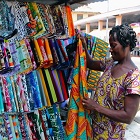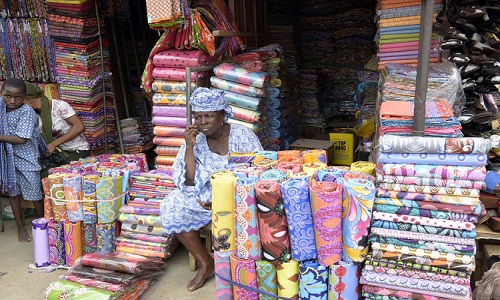"Textile, apparel and footwear industry has played a dominant role in the manufacturing sector of Nigerian economy for long. From the 1960s to 70s, with a record high of over 140 companies, Nigeria witnessed a boom in textile manufacturing with companies like Kaduna Textiles, Kano Textiles, United Nigeria Textiles, Aba Textiles, Texlon Nigeria, First Spinners, amongst others, employing about a million people."

Textile, apparel and footwear industry has played a dominant role in the manufacturing sector of Nigerian economy for long. From the 1960s to 70s, with a record high of over 140 companies, Nigeria witnessed a boom in textile manufacturing with companies like Kaduna Textiles, Kano Textiles, United Nigeria Textiles, Aba Textiles, Texlon Nigeria, First Spinners, amongst others, employing about a million people, and contributing about 15 per cent of the manufacturing sector earnings to the GDP of the Nigerian economy and accounting for over 60 per cent of the textile industry capacity in West Africa.

Following the discovery of oil and the subsequent oil boom, the government became reliant on oil and abandoned agriculture. The neglect of the agricultural sector had an adverse effect on the textile industry. The production of cotton, the basic raw material used for the manufacture of clothes regressed rapidly as its production capacity declined by 50 per cent.
Moreover, the economic regression meant manufacturers could not afford to import sophisticated modern equipment which could have facilitated the production processes. Similarly, textile manufacturers and fabric designers who could afford to import raw materials procured these at astronomical costs which had effects on their businesses. This meant the textile industry had insufficient and, at times, no raw material to work with.
A waning textile industry impacts economy
The trade liberalisation polices adopted in 1986 following the implementation of the Structural Adjustment Programme (SAP), saw the flooding of imported fabrics and finished goods, thereby degenerating the manufacturing capacity of the industry. By the 1990s, the degradation of infrastructure, especially the lack of stable electricity supply, affected textile manufacturers as they could not keep up with the strains of production and this led to the closure of a number of textile companies, with hundreds of workers rendered helpless. By 1998, the industry was operating at a capacity of just 28 per cent.
Indeed, the abysmal performance of the textile industry and the entire manufacturing sector is a sad story. The sector, which played a major role in boosting of nation’s economy and development, is suddenly a shadow of itself as the country’s manufacturing capacity, especially the textile industry, is at an all-time low and its poor performance is having a bearing on the Nigerian economy. Despite the fact that oil, Nigeria’s major source of income, is in a declining state and its overall contribution to the economy has reduced drastically, the manufacturing sector unfortunately lacks the capacity to provide relief to Nigeria’s ailing economy as it only contributes a paltry seven percent to the Gross Domestic Product (GDP) of the economy with the textile, apparel and footwear industry contributing about N1.8 billion of that in 2015, according to the National Bureau of Statistics (NBS) report.
It has, however been proven that the textile industry is indeed a driver of growth and employment globally. For example, the exports of the textile industry in Hungary edged up to 3.2 per cent in 2014 to $1.62 billion from $1.57 billion in 2013. With a strong labour population of over 43,000 in the textile industry, the involvement of medium-size enterprises in the industry and a robust export of textile products to countries such as Germany, Italy, Austria, France and Romania, a tremendous improvement has been forecasted for Hungary’s economy in 2016.
Textile industry’s influence is bigger in China with more than 100,000 manufacturers employing over 10 million people. The industry is estimated to contribute about 47 per cent to the country’s GDP, with its value of garment export believed to be around $153.219 billion as at 2013. With its percentage of the global garment market at 38 per cent, China is the world’s largest manufacturer, exporter and consumer of garments. The Chinese textile industry remains competitive due to the continued investment in the domestic industry.
Infrastructure development
Nigeria must provide enabling environment for textile manufacturers and fashion designers to thrive. Provision of critical infrastructure such as electricity and a good transport system is needed by manufacturers and designers should be made available to help them become truly productive. Also, the recently formulated policy road map for the creation of fashion clusters, the Integrated Textiles and Garment Parks (ITGPS), should be formally adopted by the present government and ensure it implements the policy provisions to the letter.
The country should also provide funding and financial incentives for members of the textile industry as it is done in other countries. Financial institutions of government such as the Bank of Industry, and the Nigeria Export-Import Bank should endeavour to provide funds to both manufacturers and designers as this would help in the long-term to grow the economy.
The government should initiate a sustained dialogue by all stakeholders in the country to ensure that they undertake a comprehensive study and solutions on how to modernise, strengthen and get the industry to perform competitively locally and ultimately globally. Only by enacting all these would the Nigerian people and economy truly benefits from the thriving textile, apparel and footwear sub-sectors of the manufacturing industry.












